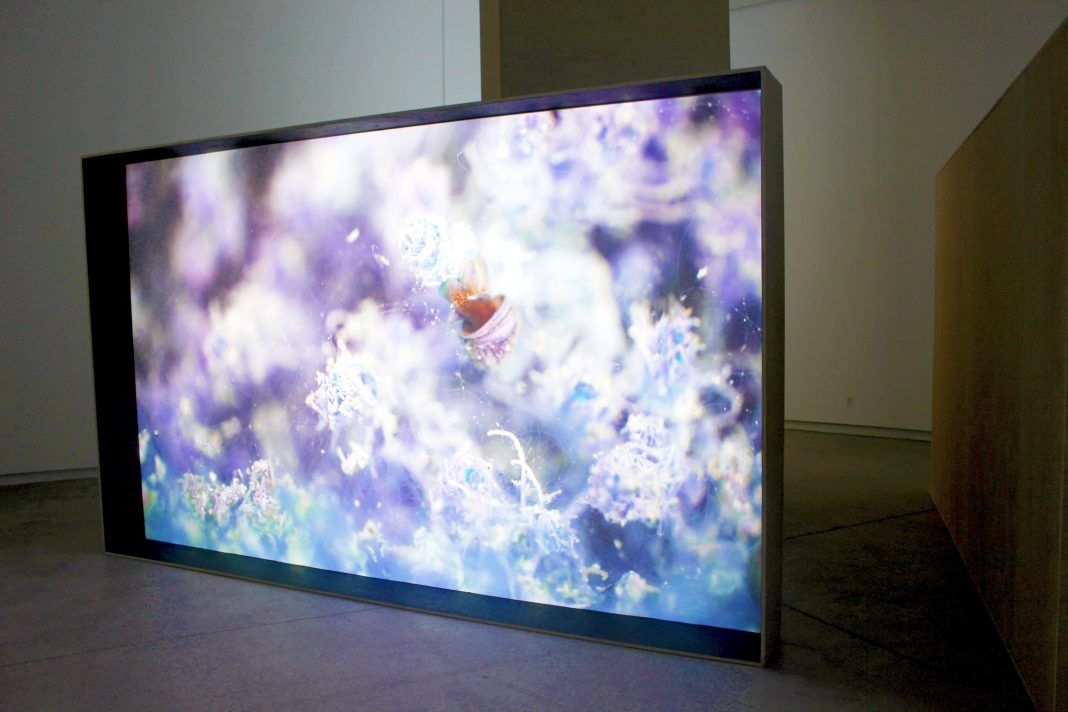Part of human nature is our ability to sense the world around us, using the biological tools that support our survival. Humans have a tendency to overlook the gift of knowledge and our capability to use natural resources to our advantage. The Blackwood Gallery showcases the significance of visual and auditory perception in their latest exhibition, Logics of Sense 1: Investigations.
The exhibition showcased work by Ursula Biemann, Mikhail Karikis, Susan Schuppli, and Jol Thomson. Each piece contains a different message, but all unite with a similar motif: our planet. The videos and sounds captured the tone of the Earth and how humans respond to various movements. The Blackwood Gallery set up the exhibition with large movie theatre-sized screens, stools, and three sound-proof headphones for each video essay. Each audio recording enhances the enthralment of the scenes displayed through the projector.
Biemann’s Acoustic Ocean is set in the Arctic. Opening with background information on oceanic studies and facts, the screen displays an ocean landscape resting underneath a bright blue sky. The video explores aquatic ecosystems with a female aquanaut gathering research. Every sound, from the preparation of the aquanaut’s equipment to ocean waves and thunderclaps, is heard. There are moments when the aquanaut wears headphones and fiddles with her research equipment. During these periods, viewers hear what she is listening to and her adjustments with the machinery. Biemann’s film explores the study of aquatic microorganisms using sound wave technology to understand navigation and communication. The video closes with a fade of the ocean landscape at night.
Karikis’s No Ordinary Protest focuses on young children in elementary school. The video opens with all the students squeezing their eyes shut. The children are engaged in a serious discussion regarding animals, humans, and the environment. This scene gives a new perspective on politics—kids think so simply, so perhaps the answers to complex problems are easy solutions, in the eyes of children. One student asks, “How do we stop the world from getting poisoned?” to which the screen flashes to a mob of children wearing colourful masks, behaving like a tribe. Karikis’s video showcases the children uniting to use their voices to advocate for change and justice.
Schuppli’s Atmospheric Feedback Loops begins with an elevator ride. The screen is mainly black, demonstrating the darkness of the elevator, and shows glimpses of light coming from the windows. The sound of the elevator gears, in motion, are heard. Schuppli’s film focuses on an open-air laboratory near Amsterdam. Researchers analyze the complex interactions of aerosols, clouds, wind, temperatures, and atmospheric densities with terrestrial events. In doing so, the laboratory gains information about climate change. The video essay showcased the land used as a resource for technological information. Audio wise, Atmospheric Feedback Loops was accompanied with dialogue from professors and researchers who shared information regarding climate change and the open-air laboratory.
Thomson’s G24|0vßß explores different epochs of Earth using physics. The video opens with the earliest microorganisms of life and zooms in on their habitat. This film covers various epochs, focusing on the specifics of each time period while showcasing the relationship between technology, nature, and humans. Majority of the audio consists of dramatic music, where the pace quickens when discoveries are shown. In particular, one epoch uses flashing colours of strobe lighting mixed with mumbling, unclear voices. This scene was interesting as it adds ambiguity to the video. Thomson’s film concludes with the notion that humans and nature are creators of the world.
If you want to experience a unique form of art, visit the Blackwood Gallery’s Logics of Sense 1: Investigations, running until October 19.



